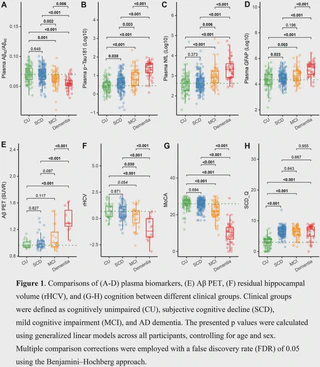Plasma biomarker and neuroimaging changes in a Chinese community aging cohort: The Greater‐Bay‐Area Healthy Aging Brain Study (GHABS)

Background To investigate the alternations of β-amyloid (Aβ), tau, neurodegeneration, and cognition in different stages of Alzheimer’s disease (AD) in the Chinese community aging population is important for early diagnosis and intervention of AD in China.
Method We recruited 422 Greater-Bay-Area Healthy Aging Brain Study (GHABS) participants from the community and completed cognitive assessments, including 100 cognitively unimpaired (CU), 189 subjective cognitive decline (SCD), 82 mild cognitive impairment (MCI) and 51 AD dementia individuals. Among them, 343 individuals had plasma Aβ42/Aβ40, p-Tau181, neurofilament light (NfL), and glial fibrillary acidic protein (GFAP) data measured by the Simoa platform. Furthermore, 159 and 96 individuals had concurrent MRI and 18F-D3-FSP Aβ PET scans, respectively. Generalized linear models were used to compare plasma biomarkers, AD typical cortical FSP Aβ standard uptake value ratio (SUVR), residual hippocampal volume (rHCV), and cognitive scores between different clinical and A/T (A: plasma Aβ42/Aβ40, T: plasma p-Tau181) groups, controlling for age and sex. Multiple comparison corrections were conducted (Benjamini-Hochberg, p<0.05). The association of plasma Aβ42/Aβ40 and p-Tau181 with plasma NfL, GFAP, Aβ PET, rHCV, MoCa, and SCD-Q were also investigated, including age, sex, and diagnosis as the covariates.
Result SCD individuals had higher plasma p-Tau181 (standardized β (βstd) = 0.251[95% confidence interval (ci): 0.031, 0.472], p = 0.038) and GFAP (βstd = 0.259[95% ci: 0.035, 0.483], p = 0.023) than the CU individuals (Figure 1). Compared to the A-/T- group, A+/T+ individuals had more (p<0.001) abnormal changes in all the plasma biomarkers, Aβ PET, rHCV, and MoCa, and A-/T+ individuals had more hippocampal atrophy (p = 0.012) and marginal higher plasma NfL (p = 0.074) (Figure 2). Continuously, lower plasma Aβ42/Aβ40 was only related to higher plasma GFAP (p<0.001), whereas plasma p-Tau181showed significant association with plasma NfL (p<0.001), plasma GFAP (p = 0.026), Aβ PET (p = 0.028), and MoCA (p = 0.023) (Figure 3).
Conclusion This study summarizes the characteristics of plasma biomarkers and brain imaging of AD and provides novel insights into the alternations of Aβ, tau, neurodegeneration, neuroinflammation, and cognition in different stages of AD in Southern China’s aging population. These findings are critical for using plasma biomarkers and neuroimaging to detect early AD changes in China.